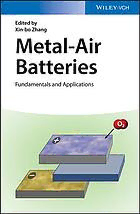
HIGH ENERGY DENSITY METAL-AIR BATTERIES. PDF
Preview HIGH ENERGY DENSITY METAL-AIR BATTERIES.
Metal–AirBatteries Metal–Air Batteries FundamentalsandApplications EditedbyXin-boZhang Editor AllbookspublishedbyWiley-VCHare carefullyproduced.Nevertheless,authors, Xin-boZhang editors,andpublisherdonotwarrantthe ChangchunInstituteofApplied informationcontainedinthesebooks, Chemistry includingthisbook,tobefreeoferrors. RareEarthResourceUtilization Readersareadvisedtokeepinmindthat No.5625RenminRd statements,data,illustrations,procedural Jilin detailsorotheritemsmayinadvertently 130022Changchun beinaccurate. China LibraryofCongressCardNo.: appliedfor BritishLibraryCataloguing-in-Publication Data Acataloguerecordforthisbookisavail- ablefromtheBritishLibrary. Bibliographicinformationpublishedby theDeutscheNationalbibliothek TheDeutscheNationalbibliotheklists thispublicationintheDeutscheNation- albibliografie;detailedbibliographic dataareavailableontheInternetat <http://dnb.d-nb.de>. ©2018Wiley-VCHVerlagGmbH&Co. KGaA,Boschstr.12,69469Weinheim, Germany Allrightsreserved(includingthoseof translationintootherlanguages).Nopart ofthisbookmaybereproducedinany form—byphotoprinting,microfilm,or anyothermeans—nortransmittedor translatedintoamachinelanguagewith- outwrittenpermissionfromthepublish- ers.Registerednames,trademarks,etc. usedinthisbook,evenwhennotspecif- icallymarkedassuch,arenottobecon- sideredunprotectedbylaw. PrintISBN: 978-3-527-34279-2 ePDFISBN: 978-3-527-80763-5 ePubISBN: 978-3-527-80765-9 oBookISBN: 978-3-527-80766-6 Typesetting SPiGlobal,Chennai,India PrintingandBinding Printedonacid-freepaper 10 9 8 7 6 5 4 3 2 1 v Contents Preface xiii 1 IntroductiontoMetal–AirBatteries:TheoryandBasic Principles 1 ZhiwenChangandXin-boZhang 1.1 Li–O Battery 1 2 1.2 Sodium–O Battery 5 2 References 7 2 StabilizationofLithium-MetalAnodeinRechargeable Lithium–AirBatteries 11 BinLiu,WuXu,andJi-GuangZhang 2.1 Introduction 11 2.2 RecentProgressesinLiMetalProtectionforLi–O Batteries 13 2 2.2.1 DesignofCompositeProtectiveLayers 13 2.2.2 NewInsightsontheUseofElectrolyte 18 2.2.3 FunctionalSeparators 25 2.2.4 Solid-StateElectrolytes 29 2.2.5 AlternativeAnodes 30 2.3 ChallengesandPerspectives 30 Acknowledgment 32 References 32 3 Li–AirBatteries:DischargeProducts 41 XuanxuanBi,RongyueWang,andJunLu 3.1 Introduction 41 3.2 DischargeProductsinAproticLi–O Batteries 43 2 3.2.1 Peroxide-basedLi–O Batteries 43 2 3.2.1.1 ElectrochemicalReactions 43 3.2.1.2 CrystallineandElectronicBandStructureofLi O 44 2 2 3.2.1.3 ReactionMechanismandtheCoexistenceofLi O andLiO 47 2 2 2 3.2.2 Superoxide-basedLi–O Batteries 52 2 3.2.3 ProblemsandChallengesinAproticLi–O Batteries 54 2 3.2.3.1 DecompositionoftheElectrolyte 54 vi Contents 3.2.3.2 DegradationoftheCarbonCathode 55 3.3 DischargeProductsinLi–AirBatteries 56 3.3.1 ChallengestoExchangingO toAir 56 2 3.3.2 EffectofWateronDischargeProducts 56 3.3.2.1 EffectofSmallAmountofWater 56 3.3.2.2 AqueousLi–O Batteries 57 2 3.3.3 EffectofCO onDischargeProducts 59 2 3.3.4 CurrentLi–AirBatteriesandPerspectives 60 Acknowledgment 61 References 61 4 ElectrolytesforLi–O Batteries 65 2 AlexR.Neale,PeterGoodrich,ChristopherHardacre,andJohanJacquemin 4.1 GeneralLi–O BatteryElectrolyteRequirementsand 2 Considerations 65 4.1.1 ElectrolyteSalts 69 4.1.2 EthersandGlymes 73 4.1.3 DimethylSulfoxide(DMSO)andSulfones 76 4.1.4 Nitriles 78 4.1.5 Amides 79 4.1.6 IonicLiquids 80 4.1.7 Solid-StateElectrolytes 86 4.2 FutureOutlook 87 References 87 5 Li–OxygenBattery:ParasiticReactions 95 XiahuiYao,QiDong,QingmeiCheng,andDunweiWang 5.1 TheDesiredandParasiticChemicalReactionsforLi–Oxygen Batteries 95 5.2 ParasiticReactionsoftheElectrolyte 96 5.2.1 NucleophilicAttack 97 5.2.2 AutoxidationReaction 99 5.2.3 Acid–BaseReaction 100 5.2.4 Proton-mediatedParasiticReaction 100 5.2.5 AdditionalParasiticChemicalReactionsoftheElectrolyte:Reduction Reaction 102 5.3 ParasiticReactionsattheCathode 102 5.3.1 TheCorrosionofCarbonintheDischargeProcess 104 5.3.2 TheCorrosionofCarbonintheRechargeProcess 106 5.3.3 Catalyst-inducedParasiticChemicalReactions 106 5.3.4 AlternativeCathodeMaterialsandCorrespondingParasitic Chemistries 110 5.3.5 AdditivesandBinders 111 5.3.6 Contaminations 111 5.4 ParasiticReactionsontheAnode 112 5.4.1 CorrosionoftheLiMetal 114 5.4.2 SEIintheOxygenatedAtmosphere 114 Contents vii 5.4.3 AlternativeAnodesandAssociatedParasiticChemistries 115 5.5 NewOpportunitiesfromtheParasiticReactions 116 5.6 SummaryandOutlook 117 References 118 6 Li–AirBattery:Electrocatalysts 125 ZhiwenChangandXin-boZhang 6.1 Introduction 125 6.2 TypesofElectrocatalyst 126 6.2.1 CarbonaceousMaterials 126 6.2.1.1 CommercialCarbonPowders 126 6.2.1.2 CarbonNanotubes(CNTs) 126 6.2.1.3 Graphene 127 6.2.1.4 DopedCarbonaceousMaterial 128 6.2.2 NobleMetalandMetalOxides 129 6.2.3 TransitionMetalOxides 130 6.2.3.1 PerovskiteCatalyst 131 6.2.3.2 RedoxMediator 133 6.3 ResearchofCatalyst 135 6.4 ReactionMechanism 138 6.5 Summary 141 References 142 7 Lithium–AirBatteryMediator 151 ZhuojianLiang,GuangtaoCong,YuWang,andYi-ChunLu 7.1 RedoxMediatorsinLithiumBatteries 151 7.1.1 RedoxMediatorsinLi–AirBatteries 151 7.1.2 RedoxMediatorsinLi-ionandLithium-flowBatteries 153 7.1.2.1 OverchargeProtectioninLi-ionBatteries 153 7.1.2.2 RedoxTargetingReactionsinLithium-flowBatteries 154 7.2 SelectionCriteriaandEvaluationofRedoxMediatorsforLi–O 2 Batteries 156 7.2.1 RedoxPotential 156 7.2.2 Stability 157 7.2.3 ReactionKineticsandMassTransportProperties 161 7.2.4 CatalyticShuttlevsParasiticShuttle 163 7.3 ChargeMediators 166 7.3.1 LiI(LithiumIodide) 170 7.3.2 LiBr(LithiumBromide) 172 7.3.3 Nitroxides:TEMPO(2,2,6,6-Tetramethylpiperidinyloxyl)and Others 176 7.3.4 TTF(Tetrathiafulvalene) 180 7.3.5 Tris[4-(diethylamino)phenyl]amine(TDPA) 182 7.3.6 ComparisonoftheReportedChargeMediators 183 7.4 DischargeMediator 186 7.4.1 IronPhthalocyanine(FePc) 190 7.4.2 2,5-Di-tert-butyl-1,4-benzoquinone(DBBQ) 192 viii Contents 7.5 ConclusionandPerspective 194 References 195 8 SpatiotemporalOperandoX-rayDiffractionStudyonLi–Air Battery 207 Di-JiaLiuandJiang-LanShui 8.1 MicrofocusedX-rayDiffraction(μ-XRD)andLi–O CellExperimental 2 Setup 207 8.2 StudyonAnode:LimitedReversibilityofLithiuminRechargeable LAB 209 8.3 StudyonSeparator:ImpactofPrecipitatestoLABPerformance 217 8.4 StudyonCathode:SpatiotemporalGrowthofLi O DuringRedox 2 2 Reaction 222 References 230 9 Metal–AirBattery:InSituSpectroelectrochemical Techniques 233 IainM.Aldous,LaurenceJ.Hardwick,RichardJ.Nichols,and J.PadmanabhanVivek 9.1 RamanSpectroscopy 233 9.1.1 InSituRamanSpectroscopyforMetal–O Batteries 233 2 9.1.2 BackgroundTheory 233 9.1.3 PracticalConsiderations 235 9.1.3.1 ElectrochemicalRoughening 235 9.1.3.2 AddressingInhomogeneousSERSEnhancement 237 9.1.4 InSituRamanSetup 238 9.1.5 DeterminationofOxygenReductionandEvolutionReaction MechanismsWithinMetal–O Batteries 239 2 9.2 InfraredSpectroscopy 247 9.2.1 Background 247 9.2.2 IRStudiesofElectrochemicalInterfaces 247 9.2.3 InfraredSpectroscopyforMetal–O BatteryStudies 249 2 9.3 UV/VisibleSpectroscopicStudies 253 9.3.1 UV/VisSpectroscopy 254 9.3.2 UV/VisSpectroscopyforMetal–O BatteryStudies 255 2 9.4 ElectronSpinResonance 257 9.4.1 CellSetup 259 9.4.2 DeploymentofElectrochemicalESRinBatteryResearch 259 9.5 SummaryandOutlook 262 References 262 10 Zn–AirBatteries 265 TongwenYu,RuiCai,andZhongweiChen 10.1 Introduction 265 10.2 ZincElectrode 266 10.3 Electrolyte 268 Contents ix 10.4 Separator 270 10.5 AirElectrode 271 10.5.1 StructureofAirElectrode 271 10.5.2 OxygenReductionReaction 271 10.5.3 OxygenEvolutionReaction 272 10.5.4 Electrocatalyst 273 10.5.4.1 NobleMetalsandAlloys 274 10.5.4.2 TransitionMetalOxides 275 10.5.4.3 Inorganic–OrganicHybridMaterials 278 10.5.4.4 Metal-freeMaterials 282 10.6 ConclusionsandOutlook 288 References 288 11 ExperimentalandComputationalInvestigationofNonaqueous Mg/O Batteries 293 2 JeffreyG.Smith,GülinVardar,CharlesW.Monroe,andDonaldJ.Siegel 11.1 Introduction 293 11.2 ExperimentalStudiesofMagnesium/AirBatteriesand Electrolytes 295 11.2.1 IonicLiquidsasCandidateElectrolytesforMg/O Batteries 295 2 11.2.2 ModifiedGrignardElectrolytesforMg/O Batteries 299 2 11.2.3 All-inorganicElectrolytesforMg/O Batteries 303 2 11.2.4 ElectrochemicalImpedanceSpectroscopy 307 11.3 ComputationalStudiesofMg/O Batteries 310 2 11.3.1 CalculationofThermodynamicOverpotentials 310 11.3.2 ChargeTransportinMg/O DischargeProducts 315 2 11.4 ConcludingRemarks 320 References 321 12 NovelMethodologiestoModelChargeTransportinMetal–Air Batteries 331 NicolaiRaskMathiesen,MarkoMelander,MikaelKuisma,Pablo García-Fernández,andJuanMariaGarcíaLastra 12.1 Introduction 331 12.2 ModelingElectrochemicalSystemswithGPAW 333 12.2.1 DensityFunctionalTheory 333 12.2.2 ConductivityfromDFTData 335 12.2.3 TheGPAWCode 337 12.2.4 ChargeTransferRateswithConstrainedDFT 338 12.2.4.1 MarcusTheoryofChargeTransfer 338 12.2.4.2 ConstrainedDFT 339 12.2.4.3 PolaronicChargeTransportattheCathode 341 12.2.5 ElectrochemistryatSolid–LiquidInterfaces 342 12.2.5.1 ModelingtheElectrochemicalInterface 342 12.2.5.2 ImplicitSolvationattheElectrochemicalInterface 343 12.2.5.3 GeneralizedPoisson–BoltzmannEquationfortheElectricDouble Layer 344 x Contents 12.2.5.4 ElectrodePotentialWithinthePoisson–BoltzmannModel 345 12.2.6 CalculationsatConstantElectrodePotential 346 12.2.6.1 TheNeedforaConstantPotentialPresentation 346 12.2.6.2 GrandCanonicalEnsembleforElectrons 347 12.2.6.3 FictitiousChargeDynamics 349 12.2.6.4 ModelinPractice 350 12.2.7 Conclusions 351 12.3 SecondPrinciplesforMaterialModeling 351 12.3.1 TheEnergyinSP-DFT 352 12.3.2 TheLatticeTerm(E(0)) 353 12.3.3 ElectronicDegreesofFreedom 354 12.3.4 ModelConstruction 357 12.3.5 PerspectivesonSP-DFT 358 Acknowledgments 359 References 359 13 FlexibleMetal–AirBatteries 367 HuishengPeng,YifanXu,JianPan,YangZhao,LieWang,andXiangShi 13.1 Introduction 367 13.2 FlexibleElectrolytes 368 13.2.1 AqueousElectrolytes 368 13.2.1.1 PAA-basedGelPolymerElectrolyte 369 13.2.1.2 PEO-basedGelPolymerElectrolyte 369 13.2.1.3 PVA-basedGelPolymerElectrolyte 371 13.2.2 NonaqueousElectrolytes 373 13.2.2.1 PEO-basedPolymerElectrolyte 373 13.2.2.2 PVDF-HFP-basedPolymerElectrolyte 377 13.2.2.3 IonicLiquidElectrolyte 377 13.3 FlexibleAnodes 378 13.4 FlexibleCathodes 381 13.4.1 ModifiedStainlessSteelMesh 381 13.4.2 ModifiedCarbonTextile 382 13.4.3 CarbonNanotube 384 13.4.4 Graphene-basedCathode 385 13.4.5 OtherCompositeElectrode 386 13.5 PrototypeDevices 386 13.5.1 SandwichStructure 387 13.5.2 FiberStructure 390 13.6 Summary 394 References 394 14 PerspectivesontheDevelopmentofMetal–AirBatteries 397 ZhiwenChangandXin-boZhang 14.1 Li–O Battery 397 2 14.1.1 LithiumAnode 397 14.1.2 Electrolyte 398 14.1.3 Cathode 398 Contents xi 14.1.4 TheReactionMechanisms 399 14.1.5 TheDevelopmentofSolid-stateLi–O Battery 399 2 14.1.6 TheDevelopmentofFlexibleLi–O Battery 400 2 14.2 Na–O Battery 401 2 14.3 Zn–airBattery 402 References 403 Index 407
